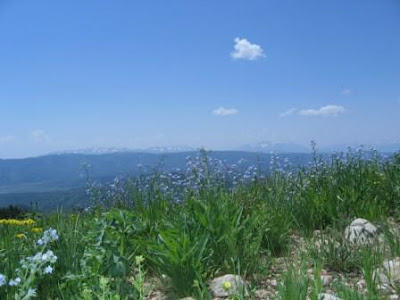
My friend Denise and I went on a grand adventure today. We trailered our horses from our separate directions (Vernal for her, Roosevelt for me) and met at the trailhead to Lake Mountain located off of the Paradise Park Road.
We did fine getting up there, well, if you don’t count my missing the Y turn that went in the Paradise Park direction and taking a little tour down Deep Creek Road. As soon as I realized nothing looked familiar and I wasn’t going toward the mountains any more, I turned around, went back to the Y, and continued to the trailhead. Even with the detour, I still reached the destination in about an hour total driving time. I beat Denise there by about 10 minutes. She called my cell phone from the Deep Creek/Paradise Park Y, also confused about the turn. Lucky for her, I knew the spot and prevented her from making my same mistake.
There was one more snafu. Denise didn’t have the key to her trailer tack room, so she couldn’t get to her saddle or bridle. Whoops. However, she was able to use Steve’s gear, so that problem was solved pretty easily.

Denise’s horse, Wystyrea, a beautiful rose grey Arab, has only been ridden for a couple of months. Even as a greenhorn, she’s a real sweetheart. No problems there. Mischief was way mellow, even more than usual, after the 30 miles he did last weekend. Thus, no one was jobbed in the dirt, always a big plus.
The wildflowers were predominantly lupine with some Indian paintrbrush at the trailhead. Wild roses bloomed along the creek. When we reached the top of the mountain, we found that Gull Lake was no longer a lake. There were a few ponds in the lake bed, but for the most part it was a vast green sedge meadow, probably marshy in the center. We didn’t see any elk or moose, and scared up only one deer.
We trotted around the lake. According to the GPS, our max speed was a respectable 9 mph. Since Denise and I were of differing opinion about where the Massey Ranch trail reached the top of Lake Mountain, we rode around a bit until we found it. We agreed that next time we’d use Marsh Peak to indicate the correct side of the lake.
I knew the approximate location of the path back to our trailer, but we had a little trouble locating the fence gap. Three riders were up there checking fences, and they pointed out where to look. I’m sure they spent the rest of their day chuckling over the two women trying to follow a GPS trackback instead of actually paying attention to landmarks. Oh, well.
This is reminiscent of other times I’ve gotten lost … er, disoriented. Tess and I took a walk around a Laundromat down in Florida, intending to circle the block and ending up on a couple of mile trek. Uhm, I think we forgot to pay attention. Likewise, on the same trip, we hunted around the airport parking lot at midnight in an attempt to find our truck. Tess was convinced the truck had been stolen, but it turned up, eventually, right where we’d parked it. And then there was the hike with my friend Kathleen to Cecret Lake, one of the most traveled and popular hiking destinations in Utah (part of the famed Albion Basin area near Alta) Well, we got to talking, took a wrong turn, and couldn’t find the lake! Oops.
Anyway, back to the Lake Mountain ride. None the worse for wear, two directionally challenged women (and their trusty mounts) returned home. And yeah, all the squiggly lines and loopy loops on my downloaded trackback map are a little embarrassing…
According to my GPS, we traveled 8 miles, 1400 feet elevation gain, in 2.5 hrs.
 The squash plants are huge. The green beans are just starting to produce. The corn and tomatoes have yet to ripen. We’re rich in fresh fruit. (I just recently read that all this stuff is really fruit, not veggies. The apple trees are likewise loaded. We will eat be eating well for a long time.
The squash plants are huge. The green beans are just starting to produce. The corn and tomatoes have yet to ripen. We’re rich in fresh fruit. (I just recently read that all this stuff is really fruit, not veggies. The apple trees are likewise loaded. We will eat be eating well for a long time. ne full circle. All we need are some pigs.
ne full circle. All we need are some pigs.



 A Brokeback Moment:
A Brokeback Moment: Sweet nothings:
Sweet nothings:


 When we were looking for a yellow lab pup, we researched the breed and found that show stock dogs are better for family, more sedate, etc. Books advise that the field trial variety have too much energy for the average household.
When we were looking for a yellow lab pup, we researched the breed and found that show stock dogs are better for family, more sedate, etc. Books advise that the field trial variety have too much energy for the average household.




 Besides the lupine I’d seen on the ride with Denise, I noticed harebells, penstemon, and purple asters.
Besides the lupine I’d seen on the ride with Denise, I noticed harebells, penstemon, and purple asters.







 The flowers turned out to be lanceleaf stonecrop, with tiny, yellow blossoms shaped much like asters.
The flowers turned out to be lanceleaf stonecrop, with tiny, yellow blossoms shaped much like asters.







 Seth and Eric reached the summit of Mount Ranier this past Sunday.
Seth and Eric reached the summit of Mount Ranier this past Sunday. 


















